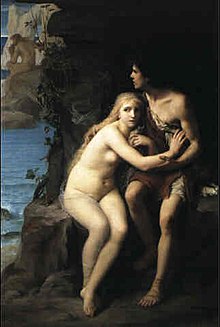Acis and Galatea


Acis and Galatea ( HWV 49) is a masque (sometimes referred to as an oratorio or Mozart in its arrangement as a pastoral ) by Georg Friedrich Händel .
Emergence
In 1708 Handel wrote the Italian-language Serenata Aci, Galatea e Polifemo . The English-language Acis and Galatea was probably written in the early summer of 1718 for the country estate of the Earl of Carnarvon (from 1719 Duke of Chandos) and has no musical features in common with the earlier composition. This first version is not divided into files. In addition to Acis, Galatea and Polyphemus, it contains the shepherd Damon as figures. Together with another tenor, the solo singers formed the singly choir.
The resumption of Acis has a similar background to that of Esther (see there). On May 17, 1732 Thomas Arne (father of the composer Thomas Augustine Arne ) produced the piece together with John Frederick Lampe and Henry Carey in the Little Theater in London . Susanna Arne (later Cibber) and Gustavus Waltz were involved as singers, both of whom later joined Handel's opera and oratorio troupe.
As with Esther, Handel responded to this competition by playing the work in a supplemented version with his Italian opera singers. To this he added numerous arias from his earlier Serenata Aci, Galatea e Polifemo , without bothering to adapt. The resulting play was organized into three acts and consisted of eight roles. The Italian singers sang in Italian, the English in English. This bilingual piece was first performed at the Haymarket on June 10 and has been repeated seven times.
In the years from 1739 onwards, Handel largely went back to the version of 1718. The most important change he made was to split the work into two acts. He shortened the duet Happy we and added a choir with the same title behind it, which now forms the end of the first part.
This late version went to press in 1743 and was the only major work of Handel that was published as a complete score during his lifetime. Today's performances are mostly based on this version.
Mozart's arrangement
Acis and Galatea is the first work by Handel that Wolfgang Amadeus Mozart arranged for Gottfried van Swieten . He added two clarinets, two bassoons and two horns and replaced the recorders with flutes. The newly instrumented Acis and Galatea (KV 566), sung in German , was made by Mozart in November 1788, later followed by the Messiah , Alexander's Feast and the Ode for St. Cecilia's Day .
libretto
The libretto was written by John Gay . The matter is derived from Greek mythology and is found for example in the Metamorphoses of Ovid , see Akis and Galatea .
people
Dramatic people according to HWV 49:
- Galatea , a nymph ( soprano ) - in the premiere probably Margherita de L'Épine
- Acis , a shepherd ( tenor ) - probably James Blackley in the WP
- Damon, a shepherd ( tenor , also boy soprano )
- Polyphemus , a cyclops ( bass )
- Choir of shepherds and shepherdesses
At the first public performance under Handel's direction in 1732, the cast was sung by the following singers:
- Acis, a shepherd - Senesino (Altkastrat)
- Galatea, a sea nymph - Anna Maria Strada (soprano)
- Polifemo, a monster - Antonio Montagnana (bass)
- Cloris - Ann Turner Robinson (soprano)
- Eurilla - Mrs. Davis (soprano)
- Dorinda - Francesca Bertolli (alto)
- Filli - Anna Bagnolesi (Alto)
- Silvio - Giovanni Battista Pinacci (tenor)
literature
- Winton Dean : Handel's Dramatic Oratorios and Masques. Clarendon, Oxford 1989, ISBN 0-19-816184-0 , (Original edition: Oxford University Press, Oxford 1959), (English).
- Hans Joachim Marx : Handel's oratorios, odes and serenatas. A compendium. Vandenhoeck & Ruprecht, Göttingen 1998, ISBN 3-525-27815-2 .
- Albert Scheibler, Julia Evdokimova: Georg Friedrich Händel. Oratorios guides . Edition Cologne, Lohmar 1993, ISBN 3-928010-04-2 .
Web links
- Score by Acis and Galatea (Handel work edition, edited by Friedrich Chrysander , Leipzig 1858)
Individual evidence
- ↑ WP = world premiere
- ↑ a b Graydon Beeks: Handel, Pepusch and Arbuthnot in Cannons , in: Stanley Sadie, Anthony Hicks (eds.): Handel, Tercentenary Collection , University Rochester Press, Ann Arbor / London, 1987, pp. 209–221, here: 213–214, excerpts online as a Google Book (English; accessed June 24, 2020)
